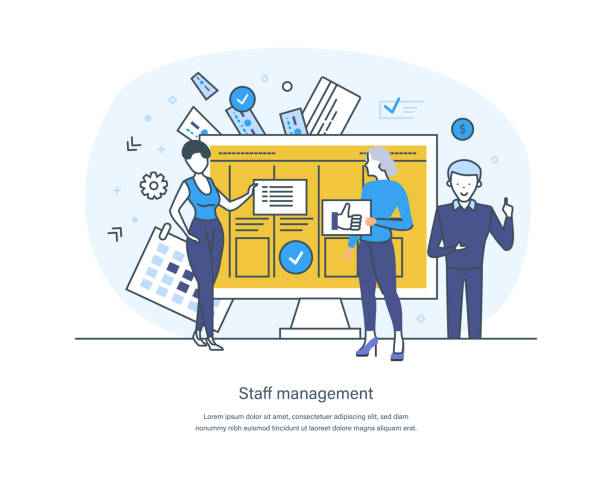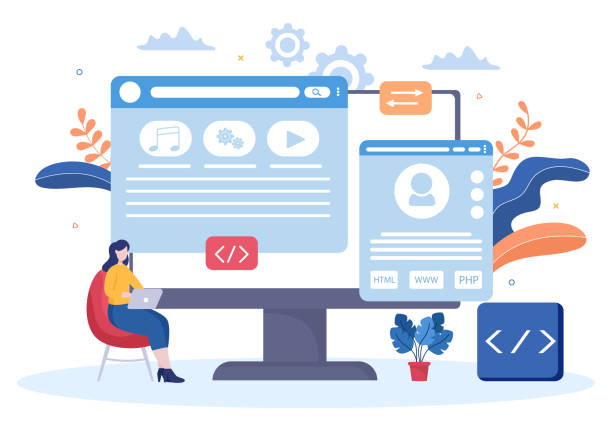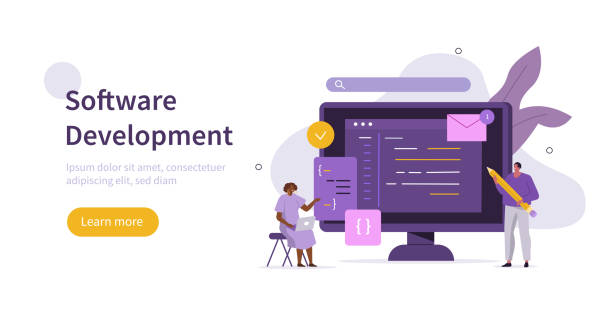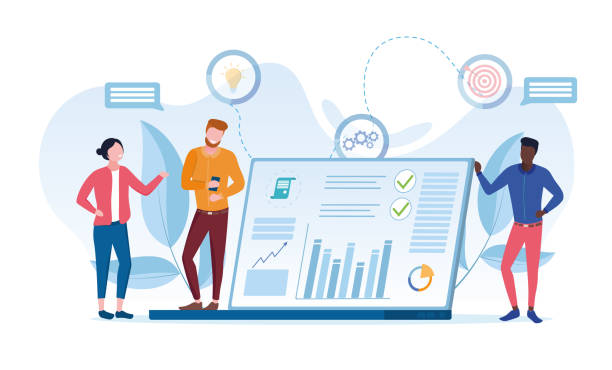Introduction to Secure Website Design and Its Necessity

In today’s fast-paced world, where businesses and social interactions are increasingly moving online, secure website design seems more vital than ever.
A website is not just a tool for displaying information; it’s a gateway to sensitive data, financial transactions, and personal communications.
Therefore, any weakness in its security can have irreparable consequences for users and website owners.
Cybersecurity in websites not only helps protect information but also builds user trust.
When users feel their information is secure on a website, they use its services with greater confidence, which leads to increased engagement and customer loyalty.
This explanatory section provides a fundamental understanding of the topic’s importance for comprehending more complex concepts to come, and explains why special attention should be paid to website security at every stage of web development.
Given continuous threats and technical complexities, a proactive approach to secure website design is a smart strategy for maintaining online stability and credibility.
The goal of this section is to clarify why security should not be a secondary component, but rather a main pillar in the structure of every modern website.
In fact, understanding how a secure website protects businesses from financial and reputational damages is the first step towards building a website resilient to attacks.
#secure_website #cybersecurity #web_design.
Disappointed with the low conversion rate of your online store? RasawWeb transforms your online store into a powerful tool for attracting and converting customers!
✅ Significant increase in visitor-to-buyer conversion rate
✅ Unparalleled user experience to boost customer satisfaction and loyalty⚡ Get free consultation from RasawWeb!
Common Cyber Threats and Strategies for Their Identification

To properly implement secure website design, it’s essential to first become familiar with common cyber threats.
#Cyber attacks can take various forms, from SQL injection attacks that allow an attacker to access the database, to XSS (Cross-Site Scripting) attacks that execute malicious code in users’ browsers.
#Malware, #phishing, and Denial-of-Service (DDoS) attacks are other serious threats that can disrupt website functionality or compromise sensitive information.
In this educational and analytical section, we delve into these threats and how to identify them early.
One of the most crucial strategies is continuous monitoring of #network_traffic and server logs.
Monitoring tools can detect unusual patterns indicative of attempted intrusions.
Furthermore, using Intrusion Detection Systems (IDS) and Intrusion Prevention Systems (IPS) can be highly effective in #identifying and blocking attacks in real-time.
Periodic security audits and penetration testing are also preventative measures that expose potential weaknesses before attackers can exploit them.
#User_education about phishing and the importance of strong passwords is also an integral part of a comprehensive website security strategy.
Understanding the depth and variety of these threats helps us adopt a more comprehensive and proactive approach to securing our online platform and preventing irreparable damage.
This deep understanding of threats is the cornerstone of any effective effort to improve website security.
Key and Foundational Principles in Secure Website Design

Secure website design goes beyond merely installing an SSL certificate; it’s a comprehensive approach that covers everything from the initial design phases to continuous website maintenance.
One of the fundamental principles is Security by Design; meaning security must be considered at every layer of the website architecture, from database design to front-end coding.
Using HTTPS protocol as a standard, encrypting sensitive data, and implementing strong authentication mechanisms (such as two-factor authentication) are other important principles.
This specialized and guiding section emphasizes the importance of input validation and #output_sanitization to prevent attacks like code injection.
Additionally, regular updates of all website components, including Content Management Systems (CMS), plugins, and themes, are crucial for patching discovered security vulnerabilities.
This proactive measure is a significant part of modern methods in secure website design.
Implementing the Principle of Least Privilege, meaning that every user or system only has access to the resources necessary for their task, is highly important.
Proper session management and countering CSRF (Cross-Site Request Forgery) attacks are also other key aspects.
Adherence to these principles in secure web architecture ensures that your website will be resilient against emerging threats not only today but also in the future.
| Protocol | Main Use | Security Level | Encryption |
|---|---|---|---|
| HTTP | Web data transfer (insecure) | Low (no security) | None |
| HTTPS | Web data transfer (secure) | High (with SSL/TLS) | Yes (SSL/TLS) |
| FTP | File transfer (insecure) | Low (no security) | None |
| SFTP | File transfer (secure via SSH) | High (with SSH) | Yes (SSH) |
| FTPS | File transfer (secure via SSL/TLS) | Medium to High (with SSL/TLS) | Yes (SSL/TLS) |
The Role of Security Protocols in Secure Website Design

Security protocols are the backbone of any secure website and play a vital role in secure website design.
The most prominent example is the HTTPS protocol, which uses an SSL/TLS certificate to encrypt communication between the user’s browser and the website server.
This encryption prevents eavesdropping, data manipulation, and Man-in-the-Middle attacks, ensuring that transmitted and received information, such as login credentials or bank card details, is securely transferred.
This specialized and explanatory section discusses the importance of Web Application Firewalls (WAFs), which act as a protective shield between the web server and the internet.
WAFs can analyze incoming traffic and identify and block known attacks like SQL injection and XSS before they reach the website.
Additionally, Intrusion Prevention Systems (IPS) and Intrusion Detection Systems (IDS), which continuously monitor the network for suspicious activities, are essential tools for protecting information on the web.
Proper server configuration and the use of HTTP security headers can also help strengthen website security.
In today’s world, not using HTTPS not only harms SEO rankings but is also perceived by users and browsers as a sign of insecurity.
Ultimately, implementing a combination of these protocols and tools provides the foundation for ensuring website security and protects your business’s data and reputation.
Are you tired of losing business opportunities due to not having a professional corporate website?
RasawWeb helps you with professional corporate website design:
✅ Build a powerful and reliable image for your brand
✅ Convert website visitors into loyal customers
⚡ Get a free consultation now!
Database Security and Preventing Data Leaks in Secure Website Design

The database is the heart of every dynamic website, containing valuable and sensitive information including user data, products, and transactions.
Therefore, database security is a critical component in secure website design.
One of the most common and dangerous attacks on databases is #SQL_injection, which allows an attacker to inject malicious SQL code into website inputs, altering the database query structure and gaining access to confidential information, or even manipulating it.
To counter this threat, using parameterized queries or Prepared Statements, as well as rigorous input validation, is essential.
This specialized and guiding section emphasizes the importance of #data_encryption during storage and in transit, especially for highly sensitive information like passwords (which should be stored as hashed values with a salt).
Applying the principle of least privilege to the database, meaning that each user or application only has access to the minimum necessary permissions for their tasks, is another vital measure.
This can be achieved by creating separate user accounts with limited access for each part of the website or application.
Continuous monitoring of database logs to identify suspicious activities and #regular_backups of information prevent data leaks and allow for quick recovery after any security incident.
All these measures together significantly contribute to increasing the website’s security resilience.
Continuous Website Updates and Maintenance for Sustainable Security

In the cyber world, where threats are constantly evolving, secure website design is not a one-time process but requires continuous maintenance and updates.
The software used on a website, from Content Management Systems (like WordPress, Joomla, Drupal) to plugins, themes, and even programming languages and web servers, are always susceptible to new vulnerabilities being discovered.
Hackers quickly exploit these vulnerabilities.
Therefore, this educational and guiding section emphasizes that applying updates as soon as they are released is a security imperative.
Ignoring updates makes your website vulnerable to known attacks.
In addition to updates, regular and automated backups of all website information (files and database) are also of paramount importance.
In the event of a successful attack or system failure, a recent backup can quickly restore your website to normal operation and prevent data loss.
Continuous monitoring of the website for any suspicious activity, such as unauthorized file changes or the appearance of malicious code, is also an essential part of security maintenance.
Security tools and malware scanners can be helpful in this regard.
These measures not only help maintain website security but also ensure its stability and availability, effectively performing data protection on the web continuously and actively.
Penetration Testing and Vulnerability Assessment

After implementing the principles of secure website design, the next crucial step is to evaluate the effectiveness of these measures through #Penetration_Testing and #Vulnerability_Scanning.
Penetration testing is a simulated and controlled attack on a website performed by security experts (usually white-hat hackers).
The goal of this test is to identify weaknesses and vulnerabilities that could be exploited by real attackers.
This specialized and analytical section emphasizes the importance of these processes in discovering hidden weaknesses.
Vulnerability scanners are automated tools that quickly scan the website to identify known vulnerabilities and provide a report of potential issues.
While scanners are highly efficient, penetration testing is deeper and can uncover more complex and logical vulnerabilities that scanners might miss.
The results of these tests include detailed reports of discovered vulnerabilities, their risk level, and recommendations for remediation.
Regularly conducting these tests, especially after major website changes, is essential for maintaining its integrity and security.
These processes actively contribute to increasing the website’s security resilience and ensure that website security assurance measures are working correctly.
This is a fundamental step in the lifecycle of secure website design and its continuous improvement.
| Stage | Description | Objective |
|---|---|---|
| Planning & Reconnaissance | Defining testing objectives, gathering initial information about the target system, such as IP addresses, domains, active services. | Understanding the target environment and planning potential attacks. |
| Scanning | Using tools to identify open ports, services, and known vulnerabilities in the system. | Discovering technical weaknesses and more information about the infrastructure. |
| Exploitation | Attempting to penetrate the system using discovered vulnerabilities and gaining access. | Proving the feasibility of penetration and assessing the depth of the vulnerability. |
| Maintaining Access | Attempting to maintain access to the system for a longer duration, simulating persistent attacks. | Assessing the system’s resilience against continuous and persistent attacks. |
| Covering Tracks & Reporting | Removing any evidence of intrusion (as part of the test) and preparing a comprehensive report of findings, recommendations, and proof of penetration. | Providing necessary information for vulnerability remediation and security improvement. |
Incident Response and Data Recovery

Even with the best secure website design approaches and strongest preventive measures, no website is completely immune to attacks.
Therefore, having an Incident Response Plan and #data_recovery is essential.
This guiding and informative section emphasizes the importance of prior planning for dealing with a #cyber_attack or data breach.
A comprehensive plan should include stages of #incident_identification, #containment, #root_cause_analysis, and #system_recovery.
Rapid incident identification is the first and most crucial step; the sooner an attack is detected, the less damage will be inflicted on the website and data.
#Incident_containment involves cutting off attacker access, isolating infected systems, and preventing damage from spreading.
After containment, the root cause of the intrusion must be identified to prevent its recurrence.
This stage often involves analyzing logs, reviewing website code, and systems to find weaknesses.
Finally, the #recovery stage includes cleaning up systems, restoring data from healthy backups and returning the website to a normal and secure state.
Transparent communication with users in case of a data breach, in accordance with privacy laws (such as GDPR), also an important part of this process.
Having such a plan not only helps speed up the recovery process but also adds to your website’s credibility and professionalism.
This proactive approach in secure web architecture is vital for every website.
Is your online sales not as expected? With RasawWeb, permanently solve the problem of low sales and poor user experience!
✅ Increase visitor-to-customer conversion rates
✅ Create an enjoyable user experience and boost customer trust
⚡ Act now to receive a free consultation!
New Challenges in Secure Website Design and Its Future

The digital age comes with new and complex security challenges that go beyond traditional concerns in secure website design.
This thought-provoking and analytical section explores these challenges.
With the growth of #Internet_of_Things (IoT) and the proliferation of connected devices, the potential attack surface has dramatically increased.
Websites interacting with these devices must consider additional security measures.
The emergence of #Artificial_Intelligence (AI) and #Machine_Learning (ML) has brought both opportunities and new threats.
While AI can play an effective role in detecting and preventing cyberattacks, on the other hand, attackers can also use it to design more sophisticated and intelligent attacks (such as advanced phishing attacks).
#Supply_Chain_Attacks, which target vulnerabilities in third-party software or libraries, have created new concerns for website security.
Another challenge is #data_privacy and stricter regulations in this area.
Websites must not only ensure information security but also comply with laws regarding data collection, storage, and processing.
Secure website design in the future will require adaptive and intelligent approaches that can keep pace with the rapid advancements in technology and attack methods.
This also includes the use of emerging technologies like #blockchain to enhance transparency and security in certain aspects.
How Can a Website Be Entertaining Yet Secure?

Secure website design doesn’t necessarily mean a dry and lifeless website.
In fact, a website can be both entertaining and engaging while maintaining the highest level of security.
This entertaining and analytical section addresses how to balance these two aspects.
Imagine an online gaming website or a social media platform where users share their personal information.
To gain user trust, security is crucial on these platforms.
However, incorporating #gamification elements, a smooth #User_Experience (UX), and appealing visual content can make the website entertaining.
The key to success is implementing security measures in a way that does not hinder the user experience.
For instance, instead of demanding overly complex passwords that users forget, two-factor authentication or secure password management can be used.
Providing #engaging and #interactive content while securely managing user data indicates successful secure website design.
Indeed, even entertaining content should be security-checked to prevent the injection of malicious code or inappropriate content.
Using attractive animations and visual effects, without reducing speed or creating security vulnerabilities, can enhance the user experience.
Securing the online platform by adhering to high standards allows the website to offer rich and engaging content without fear of intrusion.
This approach ensures that your website remains secure and appealing at all times.
Frequently Asked Questions
| No. | Question | Answer |
|---|---|---|
| 1 | What is secure website design? | Secure website design is a process in which websites are built with security measures in mind from the initial stages of development to protect against cyberattacks, unauthorized access, and data loss. |
| 2 | Why is secure website design important? | Website security is crucial for maintaining user trust, protecting sensitive information (personal and financial), preventing damage to brand reputation, and complying with privacy and security regulations (such as GDPR). A security breach can lead to financial and legal damages. |
| 3 | What are the most common cyberattacks a website faces? | Some of the most common attacks include SQL Injection, Cross-Site Scripting (XSS), Distributed Denial of Service (DDoS), Brute Force, and credential stuffing attacks. |
| 4 | What is SQL Injection and how can it be prevented? | SQL Injection is a type of attack where the attacker attempts to manipulate the database or extract information by injecting malicious SQL code into website inputs. To prevent it, Prepared Statements/Parameterized Queries, ORM (Object-Relational Mapping), and strict input validation should be used. |
| 5 | What is Cross-Site Scripting (XSS)? | XSS is a type of attack where an attacker injects malicious scripts (usually JavaScript) into web pages, which are then executed by other users’ browsers. This can lead to the theft of cookies, session information, or alteration of the website’s appearance. |
| 6 | How can Brute Force attacks on login pages be prevented? | To prevent Brute Force attacks, CAPTCHA, limiting the number of failed login attempts (Account Lockout), two-factor authentication (2FA), and using complex and long passwords should be employed. |
| 7 | What is the role of HTTPS in website security? | HTTPS encrypts the communication between the user’s browser and the website server using SSL/TLS. This prevents eavesdropping, manipulation, or forgery of information during transmission and increases user trust. |
| 8 | What is the importance of Input Validation in security? | Input validation is the process of checking and sanitizing data entered by the user. This prevents the injection of malicious code, XSS attacks, SQL Injection, and other vulnerabilities, ensuring that the data conforms to the expected format. |
| 9 | Why are regular updates of website systems and software necessary? | Regular updates of the operating system, CMS (like WordPress), plugins, themes, and libraries used, fix known security vulnerabilities. Hackers often exploit weaknesses in outdated software for intrusion. |
| 10 | What role do regular backups play in secure website design? | Regular and tested backups of website information (database and files) are a vital layer of defense against data loss due to cyberattacks, human error, or hardware failure. This enables quick website recovery in case of a disaster. |
And other services of RasawWeb Advertising Agency in the field of advertising
Smart Direct Marketing: Revolutionize click-through rates with attractive UI design.
Smart Google Ads: A new service to increase customer acquisition through the use of real data.
Smart Marketing Automation: An innovative platform to improve customer acquisition with custom programming.
Smart Advertising Campaign: A combination of creativity and technology to increase website traffic through SEO-driven content strategy.
Smart Custom Software: A combination of creativity and technology for analyzing customer behavior using real data.
And over a hundred other services in the field of internet advertising, advertising consulting, and organizational solutions
Internet Advertising | Advertising Strategy | Sponsored Articles
Resources
Comprehensive Website Security Guide
Principles of Secure Website Design
How to Secure Your Website?
Important Website Security Tips
? With RasawWeb Afarin, your business comes to life in the digital world. With expertise in secure website design, search engine optimization (SEO), and online advertising campaign management, we are with you on the path to success.
📍 Tehran, Mirdamad Street, next to Bank Markazi, Kazeroun Jonoubi Alley, Ramin Alley No. 6



